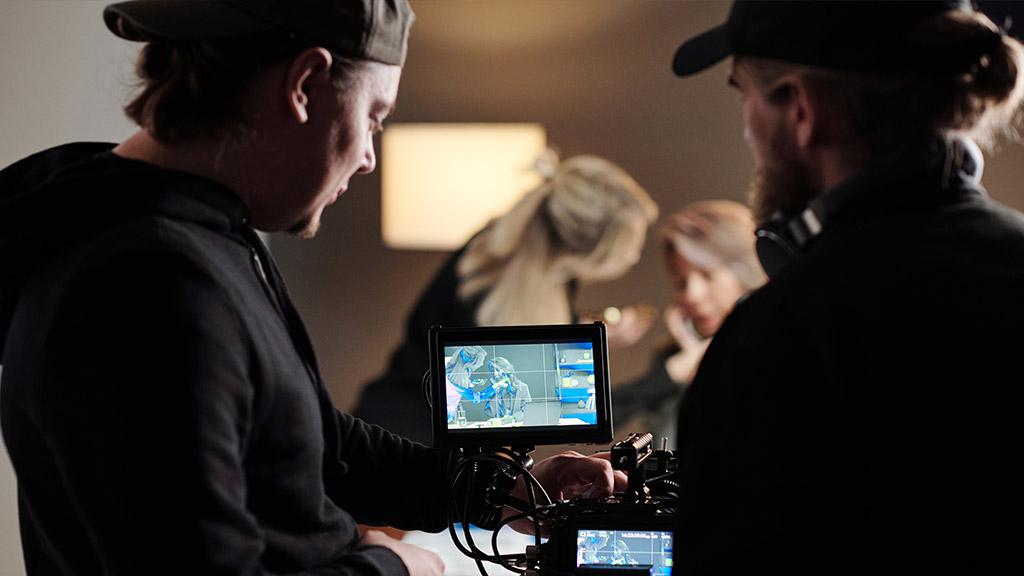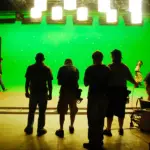As someone interested in the world of acting, you might have come across the term “stand-in actor” and wondered exactly what it means.
In essence, a stand-in actor is someone who takes the place of a leading actor during the preparation of a scene, essentially helping the film crew set up the lighting and camera angles.
This crucial role within a film or television production is often overlooked, but as a film buff, let’s delve into the specifics and importance of stand-in actors.
So, What Is a Stand-In Actor, Anyway?
With your keen interest in the film industry, you might be curious about the role of a stand-in actor. Well, let’s dig deeper into this often underappreciated profession and its importance on set.
Defining the Role: The Unsung Heroes of the Film Set
A stand-in actor is someone who takes the place of a principal actor during the technical preparations for a scene. They have a similar appearance to the main actor in terms of height, build, and complexion. This allows the director of photography and the crew to make necessary adjustments to the lighting and camera setup without tiring out the principal actor.
In this role, you become an essential part of the filmmaking process by contributing to the overall quality and efficiency of the production.
Breaking Down the Responsibilities: Lighting, Blocking, and More
As a stand-in actor, your responsibilities go beyond simply being a body double. One of your main tasks is to help with lighting setups. This includes standing in the correct position, so the crew can adjust the lights to ensure proper exposure when the principal actor later steps in.
Another crucial responsibility is assisting with blocking. This means following the director’s instructions on where to move and how to position yourself in the scene, ensuring smooth transitions and accurate framing. Apart from these tasks, you may also be asked to run lines with fellow stand-ins or background actors.
The Different Types of Stand-Ins: Which One Are You?
As a stand-in actor, you play a crucial role on set. But did you know there are different types of stand-ins? Read on to identify which category you fit into, as it can significantly impact your responsibilities and way of working.
Exploring the Variety: Single-Camera Stand-Ins and Beyond
In a single-camera production, you’ll often find yourself working as a lighting stand-in. Your primary role here is to help the crew set up and adjust lighting positions for each scene, ensuring the actors are well lit when they hit their marks.
- Photo double: A photo double closely resembles the lead actor, enabling the crew to use the stand-in for wide shots and other shots not requiring the lead’s presence.
- Body double: Sometimes referred to as stunt double, a body double typically performs specialized or dangerous actions that the principal actor may not want to take on themselves.
Understanding the Nuances: How Each Type Contributes to the Production
As a lighting stand-in, you get an opportunity to observe the filmmaking process and learn from the director of photography. It can be an excellent stepping stone to other on-set roles, like acting or even directing!
 Photo doubles might get more screen time, allowing you to make an appearance in the final cut. This could be an exciting perk for aspiring actors who want to build up their résumé and gain experience working in different filming conditions.
Photo doubles might get more screen time, allowing you to make an appearance in the final cut. This could be an exciting perk for aspiring actors who want to build up their résumé and gain experience working in different filming conditions.
Being a body double challenges you to showcase your athleticism and perform stunts. Your contributions protect the principal actors from injury, ensuring the film production stays on schedule and within budget.
Becoming a Stand-In Actor: How to Get Your Foot in the Door
Scouting for Opportunities: Keep an Eye Out for Casting Calls
When starting your journey as a stand-in, keep an eye out for casting calls. Many film and TV projects require stand-ins, and producers often advertise through job listings, online platforms, or social media. Subscribe to industry-related websites and create Google alerts to stay updated.
Don’t be afraid to reach out to your network for opportunities. Friends, mentors, and colleagues in the film industry can be invaluable resources. Remember, perseverance and determination are key, so stay patient and never stop searching.
Connecting with Professionals: Find a Casting Agency Specializing in Stand-In Actors
A great way to get started is by connecting with a casting agency that specializes in stand-in actors. Registering with such an agency can increase your chances of landing a gig. Make sure your resume, headshots, and online profiles are up to date to showcase your skills and experience.
When attending workshops, networking events, and conferences, be sure to introduce yourself to casting directors, agents, and fellow actors. By getting your name out there, you’re more likely to be remembered when someone needs a stand-in actor on their next project.
Finally, consider joining professional acting associations and online forums dedicated to stand-in actors. Here, you’ll find helpful advice, connect with like-minded individuals, and learn about new opportunities within your industry.
On-Set Etiquette: How to Make Friends and Impress the Crew
The Importance of Networking: Get to Know the Crew Members
Build genuine connections with the crew by introducing yourself and engaging in conversations. Ask questions about their roles and show appreciation for their work. This will not only help to create a positive atmosphere on set, but it may also lead to future opportunities.
Being Proactive: Participate in Props and Wardrobe Sessions
Volunteer your time and assistance during setup, props, and wardrobe sessions. Demonstrating initiative and a willingness to help wherever needed will make a lasting impression on the crew.
Tips for Success |
|---|
|
Lights, Camera, Action: Mastering the Art of Camera Blocking and Lighting
As a stand-in actor, mastering camera blocking and lighting is essential in creating a seamless and professional performance. In this section, we will cover two key sub-topics: knowing your place on the set, and understanding camera angles to create seamless transitions.
Nailing Your Mark: Know Your Place on the Set
Knowing your place on the set is crucial in helping the crew set up their shots. Be familiar with the markings on the floor, which indicate where you and the main actors should stand. Pay attention to any changes during rehearsals, and adapt accordingly.
 Communication is key. If you’re unsure about your positioning, ask the director or assistant director for clarification. Remember, your role as a stand-in is to make the filming process easier for the crew, so don’t be afraid to seek guidance when necessary.
Communication is key. If you’re unsure about your positioning, ask the director or assistant director for clarification. Remember, your role as a stand-in is to make the filming process easier for the crew, so don’t be afraid to seek guidance when necessary.
Staying Aware: Understand the Camera Angles to Create Seamless Transitions
Being aware of camera angles is an essential skill for stand-in actors. Knowing how to position yourself to create a seamless transition between you and the main actor helps to avoid delays in filming and ensures a professional outcome.
As you develop your understanding:
- Study the camera movements during rehearsals
- Make note of the focal points of each shot
- Communicate with the camera operators about preferred angles
A successful stand-in knows their role well, anticipates the needs of the crew, and adjusts their movements to fit the camera angles required for each shot. As your understanding of camera angles improves, it becomes another valuable tool in your stand-in acting toolbox.
The Finishing Touches: Tips and Tricks to Excel as a Stand-In Actor
As a stand-in actor, your role is essential to the overall filming process. Stand-ins help the primary actors by taking their places during technical preparations, providing a reference for the filming crew. To excel in this role, consider the following tips and tricks.
Always Be Prepared: Familiarize Yourself with the Script and Characters
Your job as a stand-in will be significantly more manageable if you know the script inside and out. Familiarize yourself with the characters, their motivations, and the overall storyline. Not only will this help you understand your position within the filming process, but it’ll also show the director and crew that you’re a dedicated and dependable stand-in.
Stay Sharp: Keep an Eye on Continuity and Changes Throughout the Shoot
Continuity is crucial in any film, so it’s essential for you to keep track of any changes made during shooting. Pay close attention to your wardrobe, props, and the set, ensuring they align with the primary actor’s choices. Being detail-oriented and observant will make you an invaluable stand-in, and the director and crew will appreciate your commitment to maintaining accuracy.
In summary, to become a successful stand-in actor, immerse yourself in the script, and stay on top of continuity details. By doing so, you’ll not only deliver a professional performance but also contribute to the overall quality of the finished film.
Conclusion
In your journey as a stand-in actor, you’ll find that this role offers valuable experience and exposure in the acting industry. As a stand-in, you not only help streamline the production process but also have the opportunity to observe and learn from talented actors and crew members.
Remember, your professionalism and dedication can contribute to positive recommendations and networking opportunities. Stand-in work may also serve as a gateway to more prominent acting roles. So, embracing this experience with enthusiasm and commitment sets the stage for ongoing success in your acting career.
As you continue navigating the world of acting, keep in mind the importance of versatility, communication, and adaptability. These qualities, paired with your experience as a stand-in, will undoubtedly enhance your skill set and potentially open doors to exciting endeavors in the entertainment industry.
Frequently Asked Questions
In this section, we’ll answer some frequently asked questions about stand-in actors.
What’s the Difference Between a Stand-In and a Body Double?
A stand-in is used during the technical setup for a scene to assist with lighting, camera positioning, and blocking. They are typically similar in appearance to the actor they’re standing in for. A body double, on the other hand, appears on camera and performs specific actions or scenes that the main actor may be unable or unwilling to do.
How Much Do Stand-In Actors Get Paid?
Stand-in actors’ pay can vary depending on experience, location, and the production budget. On average, a stand-in can expect to earn around $150 to $250 per day. Higher rates are possible for experienced stand-ins or those with specialized skills.
Can Being a Stand-In Actor Lead to Acting Opportunities?
While it’s not guaranteed, being a stand-in can offer networking opportunities and exposure to the film industry. As you gain experience, you may come across additional opportunities, including being considered for a speaking role or extra work on future productions.
What Skills Are Needed to Be a Successful Stand-In Actor?
Attention to detail, a strong work ethic, and the ability to take direction are essential skills for a stand-in actor. Patience and flexibility are also important, as you may be required to spend long periods of time on set awaiting scene setups and adjustments.
How Can I Find Stand-In Actor Jobs in My Area?
- Research local film and television production companies and contact them about potential stand-in opportunities.
- Network with industry professionals, such as directors, producers, and actors, both in-person and on social media.
- Join online forums and groups dedicated to the film industry to stay informed about upcoming productions and job openings.
Armed with this information, you’re well-prepared to embark on your journey as a stand-in actor!









